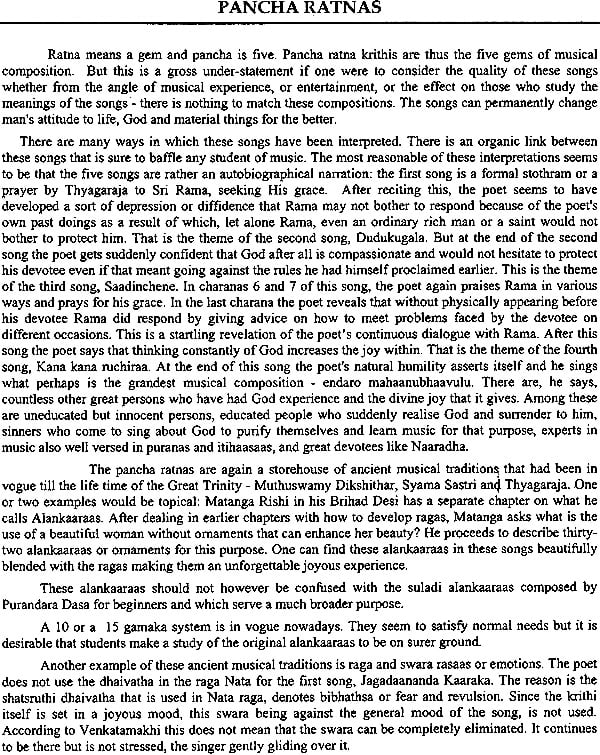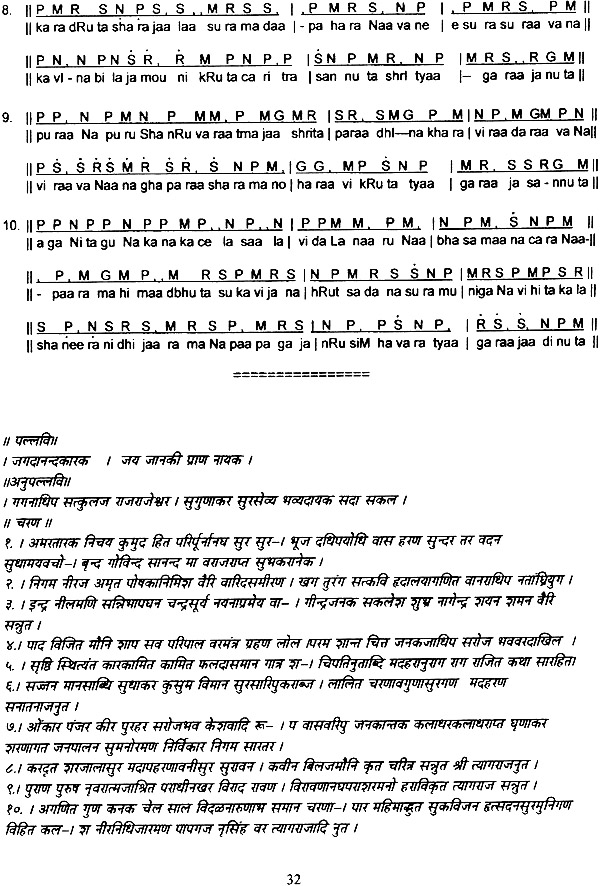
Pancharatna Kritis: Meanings and Significance (With Notation)
Book Specification
| Item Code: | NAM183 |
| Author: | G. Dwarakanath |
| Publisher: | Vasantha Vallabha Music Academy, Bengalore |
| Language: | English |
| Edition: | 2012 |
| Pages: | 49 |
| Cover: | Paperback |
| Other Details | 11.5 inch x 8.5 inch |
| Weight | 160 gm |
Book Description
The pancha ratna kritis of Thyaagaraaja are, to say the least, the greatest musical compositions whether we look at them for their musical excellence or poetical beauty or philosophical loftiness or their autobiographical contents. The poet has blended the alankaras given in ancient books so well that it becomes impossible to forget the liting melodies even after years! The personal references in the Gowla, Arabhi and Varali songs are so clear that no one would doubt that they indeed are autobiographical and the deep humility that marks the last Sri raga piece is unparalleled. The five krithis are indeed a colourful depiction of the evolution of a young man who struggles hard to overcome various temptations into a saint of unmatched excellence. It is hoped that the meanings and significance of the kritis given in simple English in this book will be useful to music lovers.
Gomatam Dwarakanath, the author, is a science and law graduate of Mysore University. Born in Bangalore, he belongs to an orthodox family of srivaishnavas, followers of Ramanuja. His ancestors hailed from Kancheepuram in Tamil Nadu and had migrated to Maloor in Channapatna district of Karnataka around the year 1780 during the Carnatic wars and consequent unsettled conditions in Kancheepuram. By tradition, the family members had always studied Telugu, perhaps due to the influence of the Vijayanagar empire under which Telugu was the state language almost in the entire South India. In 1946, at the age of 12, the author had started learning music under an able vidwan and subsequently had some advanced training in this field in the Ayyanar College of music started by the late T.Chowdiah. He joined The Hindu newspaper in Chennai in the editorial department in 1957 and retired in 2001 as Associate Editor. In Chennai he came into contact with many eminent musicians, chiefly Thanjavur Sankara Iyer, an eminent composer who taught him not only many rare krithis of Thyagaraja from the original Umayalpuram notebooks but also such ideas as a raga not being limited to the arohana and avarohana, and a janaka raga having some nuances of a janya raga also and so on. Having Tamil as the mother tongue, a native of Telugu country studying Telugu in school and college and growing up in Bangalore in the Kannada country helped him in being familiar with these languages, besides Sanskrit which he learnt. It is with this advantage that the classics were studied.
The Academy has been training students at a senior grade and encouraging them to import the simple yet powerful and effective path of 'bhakti' as enunciated by saint composers like Purandaradasa and Tyagaraja , while singing during the Aradhana celebrations. The Academy has in the past, published reprints of 'Purandara Kriti Shataka' ( 1964; Kannada) in four volumes as Purandaradasa kirtanas covering 68 songs out of the total 100. Text was added in Tamil, Devanaagari with meanings in English for wider usage. Audio CDs and cassettes for the 68 songs were also brought out.
We are presently bringing out two books on Tyagaraaja kritis in English. The first book "Forgotten Chapters in Music" deals with the nature of the components of music viz. sruti, swara, raga etc. in the former half and the meanings of Tyagaraajaa's songs' on music in the latter half. The secondbook is on the highest quality gems among Tyaagaraaja Kritis viz. "Ghanaraaga Pancharatna Kritis".
The author of these two books, Shri. G. Dwarakanath, retd. Associate Editor, The Hindu, Chennai, has a wide read knowledge on music. He also has long years of association with eminent scholars and musicians at Chennai. His commentary in English, is based on some traditional books which are in regional languages like Telugu, Tamil, Kannada, hence not easily accessible to the younger generation. Both the books, cover word by word meanings of songs, followed by a brief summary.
We have provided music notation in English for Pancharatna kritis,s based on music notation published by Sangeetha Kalanidhi Shri. Semmangudi. R. Srinivasa Iyer, who has certified that the notations are the authentic versions, having been learnt from the original Umayalpuram notebooks and authentic sishya parampara of Tyaagaraaja. We have followed standard phonetic coding while transliterating the text of the kritis to English for the music notation. Generally, uppercase English alphabets represent 'maha' prana (hard syllable) for consonants; 'deergha' (long) for vowel sounds and lower case alphabets represent 'alpa' prana (gentle syllables) for consonants; 'hrasva' (short) for vowel sounds. Free audio lessons / transliterated text in other Indian languages can be obtained on request from the Academy.
We hope that these books will be of use to students as well as all lovers of Carnatic music. We thank the staff of Elegant Printing Press, Bengalooru, for their excellent work.
| Pancha Ratnas-An introduction | 1 |
| Jagadananda Kaaraka | 2 |
| Dudukugala | 11 |
| Saadinchene | 15 |
| kana kana Ruchiraa | 19 |
| Endaro Mahaanubhavulu | 23 |
| Music notation | |
| Jagadananda Kaaraka | 30 |
| Dudukugala | 33 |
| Saadinchene | 36 |
| Kana kana Ruchiraa | 38 |
| Endaro Mahaanubhaavulu | 41 |









